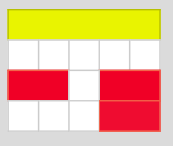Or search by topic
Number and algebra
Geometry and measure
Probability and statistics
Working mathematically
Advanced mathematics
For younger learners
Cuisenaire Counting



- Problem
- Getting Started
- Student Solutions
- Teachers' Resources
Cuisenaire Counting
Cuisenaire Counting printable sheet
I have some rods that are different colours and different lengths.
I can arrange white and red rods in many different ways to be the same length as a yellow rod. Here are some of them:

Can you find all the ways of using red and white rods that are equivalent to a yellow rod?
How will you know that you haven't missed any out?
You could use the interactivity below to try out your ideas.
The dark green rod is longer than the yellow rod.
Can you find all the ways of using red and white rods that are equivalent to a dark green rod?
How will you know that you have found them all?
Why do this problem?
This activity, offers children an environment for exploring partitioning of numbers. Ideally, learners would have real Cuisenaire rods to use, so that they can solve this problem practically as well as virtually. The activity could be used to focus on sharing strategies to find all possible solutions. These strategies can then be applied to further challenges.
Possible approach
If your children are not already familiar with Cuisenaire rods, it is essential to give them time to 'play' with the rods before having a go at this activity.
Begin the lesson by sharing the image of the yellow rod and some of the ways of making the same length using white and red rods. Try not to say anything by way of introduction or explanation, simply ask, "What do you see? What do you wonder?". Give learners a few minutes of thinking time on their own before suggesting that they talk to a partner. Invite pairs to share their noticings, or
wonderings, with the whole group, writing them up on the board without offering comment yourself. Encourage members of the class to respond to anything you have written.
At this point, introduce the Cuisenaire rods, either using physical rods, or using the interactivity. If you do not have real rods, it would also be useful for students to have access to the interactivity in pairs, for example on a tablet or computer. Try to refer to the rods using their colours rather than giving them numerical values at this stage. Referring to the discussion that has already
taken place (where appropriate), set up the first challenge of finding ways to arrange red and/or white rods so they are equivalent in length to a yellow rod. Ask a pupil to make an arrangement. Ask for another, different, arrangement and invite someone else to make that next to the first. Then set them off to see whether they can find other different ways, working in pairs. Can they find
all the ways? How will they know they have found them all?
Key questions
Possible extension
Possible support
You may also like
Let's Investigate Triangles
Vincent and Tara are making triangles with the class construction set. They have a pile of strips of different lengths. How many different triangles can they make?

